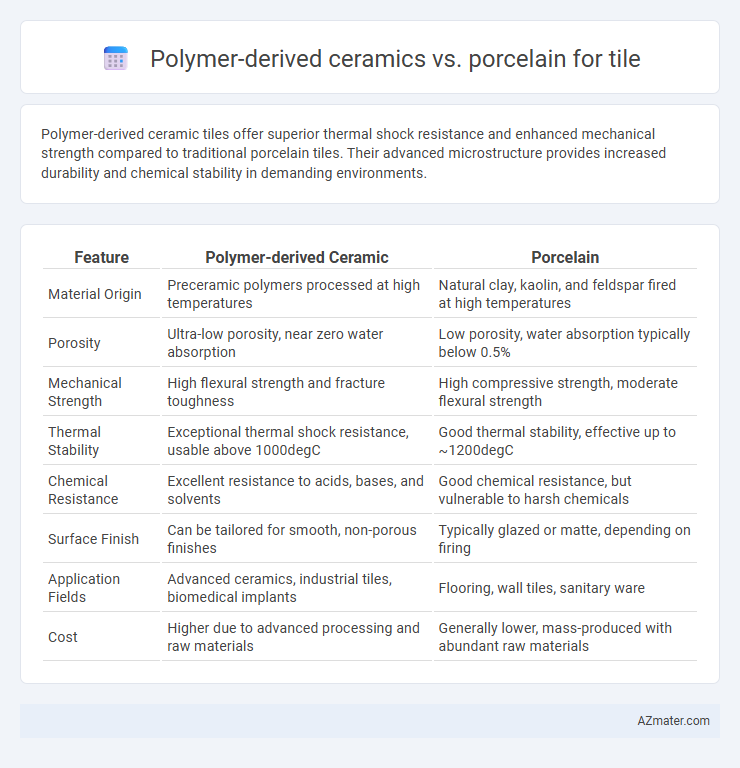Polymer-derived ceramic tiles offer superior thermal shock resistance and enhanced mechanical strength compared to traditional porcelain tiles. Their advanced microstructure provides increased durability and chemical stability in demanding environments.
Table of Comparison
| Feature | Polymer-derived Ceramic | Porcelain |
|---|---|---|
| Material Origin | Preceramic polymers processed at high temperatures | Natural clay, kaolin, and feldspar fired at high temperatures |
| Porosity | Ultra-low porosity, near zero water absorption | Low porosity, water absorption typically below 0.5% |
| Mechanical Strength | High flexural strength and fracture toughness | High compressive strength, moderate flexural strength |
| Thermal Stability | Exceptional thermal shock resistance, usable above 1000degC | Good thermal stability, effective up to ~1200degC |
| Chemical Resistance | Excellent resistance to acids, bases, and solvents | Good chemical resistance, but vulnerable to harsh chemicals |
| Surface Finish | Can be tailored for smooth, non-porous finishes | Typically glazed or matte, depending on firing |
| Application Fields | Advanced ceramics, industrial tiles, biomedical implants | Flooring, wall tiles, sanitary ware |
| Cost | Higher due to advanced processing and raw materials | Generally lower, mass-produced with abundant raw materials |
Introduction: Polymer-Derived Ceramics and Porcelain Tiles
Polymer-derived ceramics (PDCs) are advanced materials synthesized from preceramic polymers, offering superior thermal stability, mechanical strength, and chemical resistance compared to traditional ceramics. Porcelain tiles, composed mainly of kaolin, quartz, and feldspar, are renowned for their durability, low water absorption, and aesthetic versatility in flooring and wall applications. While porcelain remains a staple for residential and commercial tiling, polymer-derived ceramics introduce innovative properties that enhance performance under extreme conditions and extend the application range in high-tech environments.
Composition and Material Origins
Polymer-derived ceramics originate from preceramic polymers that undergo pyrolysis, resulting in a dense, amorphous structure with enhanced thermal stability and resistance to chemical corrosion. Porcelain tiles are made from a blend of refined clay, feldspar, and quartz fired at high temperatures, producing a vitrified, crystalline material known for its hardness and low porosity. The fundamental difference lies in the synthetic polymer-based precursors for polymer-derived ceramics versus natural mineral-based raw materials in porcelain, influencing their durability, thermal performance, and application suitability.
Manufacturing Processes Compared
Polymer-derived ceramics are produced through the controlled pyrolysis of preceramic polymers, enabling precise microstructural control and lower sintering temperatures compared to traditional porcelain, which is made by firing natural clay and minerals at high temperatures. The polymer-derived process allows for enhanced material homogeneity and tailored compositions, resulting in superior mechanical properties and increased thermal resistance. Porcelain manufacturing relies on vitrification during firing, creating dense, durable tiles but with less flexibility in microstructural design and higher energy consumption.
Mechanical Properties and Strength
Polymer-derived ceramics exhibit superior mechanical properties such as higher fracture toughness and impact resistance compared to traditional porcelain tiles, making them more durable under stress. Their intrinsic microstructure provides enhanced flexural strength, often surpassing porcelain's typical compressive strength range of 30-70 MPa. This makes polymer-derived ceramic tiles an ideal choice for applications demanding high mechanical performance and long-lasting structural integrity.
Thermal and Chemical Resistance
Polymer-derived ceramics exhibit superior thermal resistance compared to porcelain, withstanding temperatures exceeding 1400degC without structural degradation, making them ideal for high-heat applications. Chemically, polymer-derived ceramics resist a broader range of acids and alkalis due to their non-porous, covalently bonded structure, whereas porcelain may suffer surface etching or discoloration under prolonged exposure. The enhanced thermal shock resistance and chemical inertness of polymer-derived ceramics provide a significant advantage in environments demanding durability and stability.
Aesthetic Qualities and Finishes
Polymer-derived ceramics offer superior aesthetic flexibility with customizable colors, textures, and glossy or matte finishes, providing a modern and sleek appearance for tiles. In contrast, porcelain tiles are valued for their classic, natural stone-like look with rich, earthy tones and a wide range of glazing options that enhance durability and visual appeal. Both materials enable high-definition printing and surface treatments, but polymer-derived ceramics excel in achieving innovative, contemporary designs while porcelain remains preferred for timeless elegance.
Durability and Longevity in Applications
Polymer-derived ceramic tiles exhibit superior durability due to their enhanced chemical resistance and toughness compared to traditional porcelain tiles. These tiles offer exceptional longevity in harsh environments, resisting wear, thermal shock, and corrosion better than porcelain. Porcelain, while dense and hard, tends to be more brittle, making polymer-derived ceramics a preferable choice for industrial and high-traffic applications.
Environmental Impact and Sustainability
Polymer-derived ceramic tiles offer a lower environmental impact compared to traditional porcelain tiles due to their energy-efficient manufacturing process and reduced raw material consumption. The use of advanced polymers in ceramics lowers CO2 emissions and enhances recyclability, making them a more sustainable choice in tile production. Porcelain tiles, while durable and widely used, require higher firing temperatures, resulting in increased energy use and a larger carbon footprint.
Cost Analysis and Market Availability
Polymer-derived ceramic tiles typically present higher production costs due to advanced material synthesis and lower economies of scale compared to traditional porcelain tiles, which benefit from well-established manufacturing processes and widespread availability. Porcelain tiles dominate the market with more competitive pricing and easier accessibility in global distribution networks, making them a cost-effective choice for large-scale projects. The premium pricing of polymer-derived ceramics is justified by enhanced performance attributes, including superior durability and chemical resistance, appealing to niche markets despite limited market availability.
Optimal Applications: Choosing the Right Tile Material
Polymer-derived ceramics excel in high-temperature resistance and mechanical strength, making them ideal for industrial flooring and environments requiring exceptional durability and chemical stability. Porcelain tiles offer superior water resistance, aesthetic versatility, and are best suited for residential and commercial interior spaces, including bathrooms and kitchens. Selecting the right tile material depends on balancing application demands like exposure to wear, moisture, thermal conditions, and design requirements.

Infographic: Polymer-derived ceramic vs Porcelain for Tile
 azmater.com
azmater.com